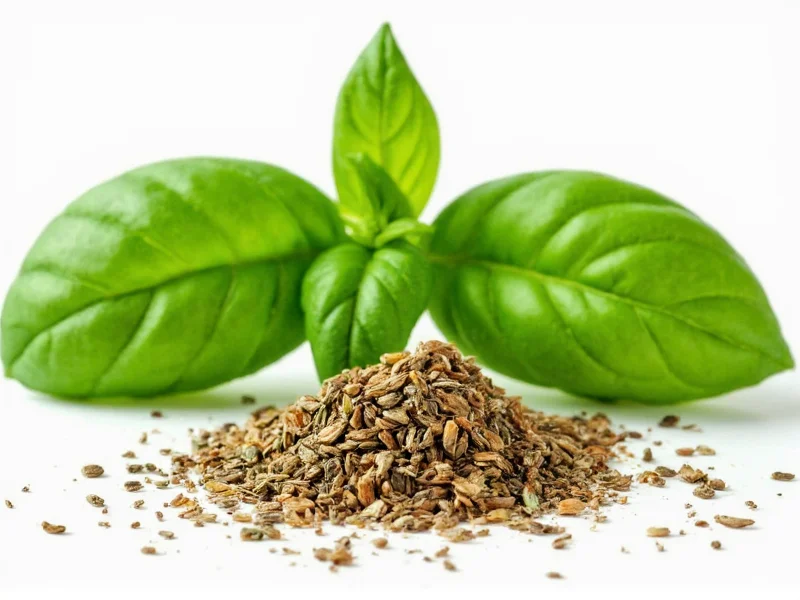When substituting dried basil for fresh in your recipes, understanding the proper conversion ratio is essential for achieving balanced flavors. The general rule in culinary practice is that dried herbs are approximately three times more potent than fresh herbs because the drying process concentrates their essential oils while removing moisture.
Why the 3:1 Conversion Ratio Matters
Fresh basil contains about 90% water, which evaporates during the drying process. This concentration effect means you need significantly less dried basil to achieve a similar flavor intensity. Using equal amounts would result in an overpowering, potentially bitter taste that could ruin your dish.
Chef's note: While the 3:1 ratio works well for most applications, some experienced cooks adjust slightly based on the specific dish. For delicate sauces or finishing touches, you might use a bit less dried basil (closer to a 2.5:1 ratio) to prevent overwhelming other flavors.
Complete Basil Conversion Reference Guide
| Measurement | Fresh Basil | Dried Basil |
|---|---|---|
| Teaspoon | 1 teaspoon | ⅓ teaspoon |
| Tablespoon | 1 tablespoon | 1 teaspoon |
| Tablespoon | 2 tablespoons | 2/3 tablespoon (or 2 teaspoons) |
| Cup | 1 cup | ⅓ cup |
When to Use Dried Versus Fresh Basil
Understanding when to use each form enhances your cooking results:
- Dried basil shines in long-cooking dishes like soups, stews, and tomato sauces where its concentrated flavor can gradually infuse throughout the cooking process
- Fresh basil excels as a finishing herb in salads, pesto, caprese dishes, and delicate sauces where its bright, grassy notes remain vibrant
- Pro tip: For the best flavor when using dried basil, bloom it by adding it to warm oil or liquid early in the cooking process to release its essential oils
Maximizing Flavor with Dried Basil Substitutions
When converting recipes that call for fresh basil to use dried instead, consider these professional techniques:
- Add dried basil earlier in the cooking process to allow time for rehydration and flavor development
- Crush dried basil between your fingers before adding to release more flavor compounds
- For dishes where fresh basil would be added at the end, reduce the dried basil amount by 25% and add it during the last 10-15 minutes of cooking
- Always taste and adjust—dried herb potency varies based on age and storage conditions
Storage Tips for Optimal Flavor Preservation
Proper storage significantly impacts how much dried basil equals fresh in terms of flavor intensity:
- Fresh basil: Store stems in water like flowers (change water daily) or wrap loosely in damp paper towels in a container; lasts 5-7 days refrigerated
- Dried basil: Keep in airtight containers away from light and heat; properly stored, maintains peak flavor for 1-2 years
- Flavor test: Rub a small amount between your fingers—if you can't smell a strong aroma, it's lost potency and you'll need to use slightly more than standard conversion ratios
Common Substitution Mistakes to Avoid
Even experienced cooks sometimes make these errors when converting how much dried basil equals fresh measurements:
- Using equal volumes: This results in overly strong, sometimes bitter flavors
- Adding dried herbs too late: They need time to rehydrate and release flavors
- Not accounting for age: Older dried herbs lose potency, requiring slight adjustments to conversion ratios
- Ignoring dish type: Using dried basil in dishes that specifically require fresh's delicate flavor profile
Adjusting for Personal Taste Preferences
While the standard conversion of 2/3 tablespoon dried basil for 2 tablespoons fresh provides a reliable starting point, personal taste and specific recipe requirements may warrant adjustments. Some Mediterranean chefs prefer a slightly more generous ratio of 3:1.5 for basil specifically, as its flavor compounds are somewhat delicate compared to hardier herbs like oregano or thyme.
When experimenting with how much dried basil equals 2 tablespoons fresh in your favorite recipes, start with the standard conversion, then adjust in your next preparation based on your taste preferences. Remember that dried basil's flavor develops more slowly but lasts longer in dishes, while fresh basil provides an immediate but more fleeting aroma.











 浙公网安备
33010002000092号
浙公网安备
33010002000092号 浙B2-20120091-4
浙B2-20120091-4